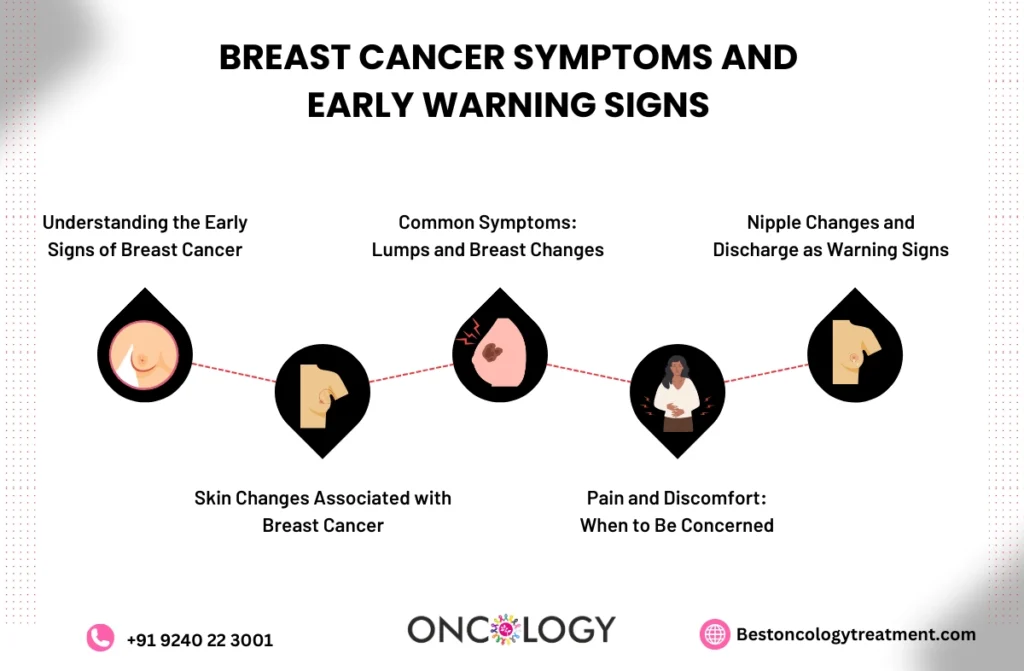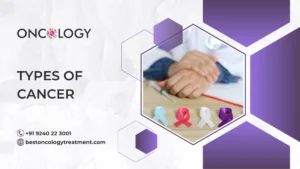The symptoms and signs of breast cancer are essential to recognize, as early detection can make a significant difference in treatment options and outcomes. Awareness of these symptoms and signs of breast cancer empowers individuals to take proactive steps if they notice any unusual changes in their bodies. This blog post will discuss the primary symptoms, unique signs based on demographics, and how symptoms can differ at advanced stages, aiming to provide a comprehensive understanding of what to look for.
What Are the Symptoms and Signs of Breast Cancer?
The symptoms and signs of breast cancer can vary widely and may not be immediately noticeable. Common indicators include the presence of a new lump or mass in the Signs and Symptoms of Stage of Breast Cancer or underarm, swelling or thickening of breast tissue, changes in the size or shape of the breast, and persistent breast pain. Other symptoms to watch for are skin changes such as redness, dimpling, or an orange peel texture, as well as nipple inversion, discharge (sometimes blood-stained), or unusual sensitivity. Recognizing these early signs and symptoms of breast cancer is essential for prompt diagnosis and effective treatment.

What is a Normal Breast?
Before identifying abnormalities, it is essential to understand what a normal breast looks and feels like. A normal breast:
- Has smooth, lump-free tissue.
- Can feel slightly lumpy before menstruation.
- Has uniform skin tone without redness or dimpling.
- Shows no unexplained changes in size or shape.
- Has nipples that do not retract unless naturally occurring.
If you notice any deviation from these normal characteristics, consult a healthcare professional, as it could indicate Early Signs and Symptoms of Breast Cancer.
Early Warning Signs of Invasive Breast Cancer
Recognizing Early Signs and Symptoms of Breast Cancer is essential for early detection. Some of the most common early warning signs include:
- New Lumps – Hard, painless lumps in the breast or underarm.
- Skin Changes – Redness, dimpling, or puckering of breast skin.
- Nipple Discharge – Unexplained fluid leakage, especially bloody discharge.
- Nipple Retraction – A newly inverted nipple can be a warning sign.
- Persistent Pain – Unexplained pain that doesn’t go away.
- Size or Shape Changes – One breast appearing larger or misshapen.
- Swollen Lymph Nodes – Swelling in the underarm area or collarbone.
Signs and Symptoms of Breast Cancer?
Recognizing the symptoms and signs of breast cancer is essential for early detection and effective management. The early signs and symptoms of breast cancer often include:
- A new lump or mass in the breast or underarm area.
- Swelling or thickening of the breast tissue.
- Skin irritation, dimpling, or puckering on the breast.
- Redness, scaliness, or flaking of the nipple or breast skin.
- Unusual nipple discharge, which may be clear or blood-stained.
- Pain in any part of the breast or persistent discomfort.
- Enlarged lymph nodes near the collarbone or armpit.
Understanding these warning signs and symptoms of breast cancer can help individuals seek medical advice promptly, improving outcomes.
What Are the Complications of Breast Cancer ?
Breast cancer can lead to a range of health issues that affect both physical and emotional well-being. These complications may result from the disease itself or from the treatments used.
Common complications include :
- Cancer spreading to other organs like the liver or bones
- Swelling in the arm (lymphedema) after lymph node removal
- Persistent fatigue or pain from treatments
- Infections after surgery or chemotherapy
- Nerve damage, causing tingling or numbness
- Emotional distress such as anxiety or depression
- Fertility problems due to chemotherapy
- Heart issues from radiation or specific drugs
The risk and severity of complications depend on how early the cancer is diagnosed and how the body responds to treatment. Recognizing the early signs of breast cancer such as a new lump, skin changes, or nipple discharge—can help prevent complications by allowing for earlier intervention. Early treatment usually results in fewer side effects and better outcomes. Regular follow-ups, a supportive care plan, and lifestyle adjustments can help manage these challenges and improve quality of life for survivors.
Types of Breast Cancer
Breast cancer comprises various types, each with distinct features:
- Ductal Carcinoma In Situ (DCIS): This is a non-invasive form of breast cancer where abnormal cells are confined to the milk ducts but have not spread to surrounding tissues.
- Invasive Ductal Carcinoma (IDC): The most common type of breast cancer, IDC begins in the milk ducts and spreads to the surrounding breast tissue and potentially to other parts of the body.
- Lobular Carcinoma In Situ (LCIS): While non-invasive, LCIS indicates an increased risk of developing invasive breast cancer in the future, often in both breasts.
- Inflammatory Breast Cancer: A rare but aggressive form of breast cancer that causes the breast to appear red, swollen, and warm, often without a distinct lump.
- Triple-Negative Breast Cancer: This type lacks receptors for estrogen, progesterone, and HER2, making it harder to treat with standard hormone therapies and targeted treatments.
Each type requires different Early Signs and Symptoms of Breast Cancer treatment approaches, symptoms and signs of breast cancer and early detection is critical for better outcomes.
Stages of Breast Cancer
Signs and Symptoms of Stage of Breast Cancer reflect the extent of its spread and severity, guiding treatment decisions:
- Stage 0: Known as carcinoma in situ, this is a non-invasive stage where cancer is confined to the milk ducts (e.g., DCIS) and has not spread to surrounding tissues.
- Stage I: Early invasive cancer, where the tumor is typically smaller than 2 cm in size and has not spread to lymph nodes or other parts of the body.
- Stage II: The tumor is larger than 2 cm or may have spread to a few nearby lymph nodes. The symptoms and signs of breast cancer has not yet spread to distant organs.
- Stage III: A locally advanced stage, where cancer has spread extensively to the lymph nodes under the arm, near the breastbone, or in other nearby areas. The tumor may also be larger.
- Stage IV: Metastatic breast cancer, where the cancer has spread to distant organs such as the bones, lungs, liver, or brain. This stage is considered the most advanced.
Each stage demands a tailored treatment approach, Early Signs and Symptoms of Breast Cancer and early detection significantly improves treatment outcomes.
Diagnosis and Tests
Diagnosing breast cancer involves a series of tests to confirm the symptoms and signs of breast cancer and Early Signs and Symptoms of Breast Cancer assess its progression:
- Mammography: A specialized X-ray to detect lumps or abnormalities.
- Ultrasound: Differentiates between solid masses and fluid-filled cysts.
- Biopsy: Tissue sample analysis to confirm cancer.
- MRI: Provides detailed imaging to assess the extent of cancer.
- Genetic Testing: Identifies inherited mutations like BRCA1 or BRCA2.
These tests are essential for identifying the early signs and symptoms of breast cancer and determining the most effective treatment.
What Is Self-Breast Examination ?
A self-breast examination (SBE) is a simple way to check your breasts at home. It helps you notice changes early and understand what feels normal for your body.
Steps to perform a breast self-exam:
- Stand before a mirror and check for changes in shape or color
- Raise your arms to observe movement and symmetry
- Use your fingertips in a circular motion to feel for lumps
- Check your armpits for any swelling or tenderness
- Try it while lying down or in the shower for better results
Doing this monthly—preferably a few days after your period—helps you stay aware of any unusual signs. While it doesn’t replace professional exams, it can help identify the early signs of breast cancer, such as a new lump, skin dimpling, or nipple inversion. If anything seems different or concerning, it’s important to consult a doctor.
Regular self-exams, combined with clinical exams and mammograms, increase your chances of detecting breast cancer in its earliest stages. Developing this habit builds confidence and promotes proactive health monitoring.

Causes of Breast Cancer
The exact cause of breast cancer is not always clear, but several risk factors can increase the likelihood of developing the disease. Some common causes include:
- Genetic Mutations – BRCA1 and BRCA2 gene mutations significantly raise the risk.
- Hormonal Changes – High estrogen levels may contribute to breast cancer.
- Age and Gender – Older individuals and women are at a higher risk, but men can develop it too.
- Lifestyle Factors – Smoking, alcohol consumption, and obesity are linked to an increased risk.
- Radiation Exposure – Previous exposure to radiation therapy can elevate risk.
Understanding these factors can help in taking preventive measures against Symptoms and Signs of Breast Cancer.
Other Causes of Breast Changes
Breast changes are common and are not always linked to cancer. Hormones, aging, and other non-cancerous conditions often cause these changes.
Some non-cancerous causes include:
- Hormonal changes from menstruation, pregnancy, or menopause
- Fibrocystic breasts, which feel lumpy or tender
- Cysts—fluid-filled sacs that may appear suddenly
- Fibroadenomas—solid, non-cancerous breast lumps
- Infections like mastitis, especially during breastfeeding
- Physical trauma or injury
- Medications affecting hormone levels
- Gynecomastia in men due to hormonal shifts
These conditions are usually harmless, but it’s important not to ignore them. Some symptoms can resemble the early signs of breast cancer, such as a lump or skin dimpling. That’s why any persistent or unusual breast change should be checked by a healthcare professional. Timely medical evaluation can provide reassurance or lead to early treatment if needed. Even when changes are non-cancerous, understanding them helps maintain breast health and avoid unnecessary stress. Regular self-examinations and routine screenings are key in spotting any concerns early and taking the right steps for your health.
Prevention
Although symptoms and signs of breast cancer cannot always be prevented, Warning Signs and Symptoms of Breast Cancer certain lifestyle changes can reduce risk:
- Maintain a healthy weight.
- Engage in regular physical activity.
- Limit alcohol intake.
- Avoid smoking and exposure to harmful chemicals.
- Breastfeed if possible.
- Undergo regular screenings and mammograms as recommended.
Proactively monitoring for early signs and symptoms of breast cancer is crucial in preventing advanced stages of the disease.
How Is Breast Cancer Treated?
Breast cancer treatment involves a combination of approaches, depending on the type, stage, and individual characteristics of the symptoms and signs of breast cancer. The primary treatment options include:
- Surgery: This is often the first treatment, Signs and Symptoms of Stage of Breast Cancer where the tumor or the entire breast may be removed (mastectomy) depending on the size and location of the tumor.
- Chemotherapy: This uses powerful drugs to destroy cancer cells or stop them from growing. It can be used before surgery (neoadjuvant) to shrink the tumor or after surgery (adjuvant) to eliminate any remaining cancer cells.
- Radiation Therapy: High-energy radiation is used to target and destroy cancer cells, particularly after surgery, to ensure any remaining cancer cells are treated.
- Hormone Therapy: For hormone receptor-positive breast cancer, medications like tamoxifen or aromatase inhibitors are used to block the hormones that fuel cancer growth.
- Targeted Therapy: This approach focuses on specific molecules involved in cancer growth and aims to block their action. Drugs like Herceptin target HER2-positive breast cancer.
- Immunotherapy: This treatment helps the body’s immune system recognize and fight cancer cells. It is often used for advanced or aggressive types of breast cancer.
Treatment plans are tailored to each patient, symptoms and signs of breast cancer combining these methods to ensure the best possible outcome. Regular follow-up care is essential to monitor for recurrence and manage side effects.
How Breast Cancer Spreads
Breast cancer doesn’t always stay in the breast. If not detected early, it can move to other areas in the body. Understanding how this happens can help in recognizing serious stages.
Ways breast cancer spreads include:
- Invasion of nearby tissue, such as skin or muscle
- Lymphatic system, allowing cells to travel to lymph nodes
- Blood vessels, spreading cancer to distant organs
- Within the breast, through ducts or lobules
Once cancer enters the bloodstream or lymphatic system, it can spread to bones, lungs, liver, or brain. This is known as metastatic or stage IV breast cancer. Symptoms vary depending on where the cancer travels—for example, bone pain or difficulty breathing.Spotting the early signs of breast cancer, such as a firm lump, nipple changes, or breast shape distortion, can help catch it before it spreads. Early diagnosis offers better treatment choices and higher survival rates. Imaging tests and biopsies help determine how far the cancer has gone. The sooner treatment begins, the better the chances of stopping its spread and improving overall outcomes.
What Do Lumps in My Breast Mean?
Lumps in the breast are one of the most common concerns associated with breast cancer. However, not all lumps are cancerous. Many lumps are benign (non-cancerous), such as cysts or fibroadenomas. Still, any new lump in the breast should be checked by a healthcare provider to rule out breast cancer.
Lumps that require attention include:
- Lumps that are hard, irregular in shape, or immovable.
- Lumps that change in size or become painful over time.
- Lumps that are accompanied by other symptoms, such as nipple discharge or changes in the skin.
It is important to note that most breast lumps are not cancerous, but early detection is key to effective treatment, so it’s always advisable to see a doctor for a proper diagnosis.
Medicines and Operations for Those with a High Risk of Breast Cancer
For individuals at high risk of developing breast cancer due to family history or genetic factors, preventive measures may be suggested. These measures include medicines and surgeries aimed at reducing the risk of cancer.
Preventive Medicines for High-Risk Individuals:
- Tamoxifen: This medication is often prescribed for women with a high risk of breast cancer, as it can block the hormone estrogen, which is known to fuel the growth of some types of breast cancer.
- Aromatase Inhibitors: These drugs can also lower estrogen levels and may be used for postmenopausal women to reduce breast cancer risk.
Preventive Surgeries:
- Prophylactic Mastectomy: For women with a very high risk of developing breast cancer (such as those with BRCA1 or BRCA2 gene mutations), a preventive mastectomy, which involves the removal of both breasts, may be considered to lower the risk.
- Oophorectomy: The removal of ovaries is another option for high-risk women, especially when paired with a BRCA mutation. This can reduce the production of hormones that fuel certain types of breast cancer.
- Lumps in the breast that feel hard or immovable.
- Change in breast size, shape, or texture (skin dimpling or redness).
- Pain in the breast or nipple area, particularly if persistent.
- Nipple discharge, particularly if it is clear or blood-tinged.
- Enlarged lymph nodes near the breast or under the arm.
- Skin changes such as redness or thickening.
What Are Treatment Side Effects?
Treatment for breast cancer can have a range of side effects due to the intensity of therapies used. symptoms and signs of breast cancer Common side effects include:
- Fatigue and Weakness: Many patients experience extreme tiredness and general weakness, which can affect daily activities and quality of life.
- Nausea, Vomiting, and Loss of Appetite: Chemotherapy drugs can cause nausea and vomiting, leading to a loss of appetite and difficulty maintaining a healthy diet.
- Hair Loss: Chemotherapy, which targets rapidly dividing cells, can result in temporary hair loss, affecting both the scalp and body hair.
- Skin Irritation and Sensitivity: Radiation therapy can cause skin irritation, redness, and sensitivity in the treated area, often resembling sunburn.
- Hormonal Changes: Hormone therapies can induce side effects like hot flashes, mood swings, and changes in menstrual cycles. These hormonal fluctuations may also lead to a reduction in bone density or affect sexual health.
While these symptoms and signs of breast cancer side effects can be challenging, they are often temporary, and healthcare providers can help manage symptoms and improve comfort during treatment.
What Is the Survival Rate for Breast Cancer?
Survival rates vary depending on the symptoms and signs of breast cancer stage of diagnosis. Recent data highlights:
- Stage 0 and I: Nearly 100% five-year survival rate.
- Stage II: Approximately 93% five-year survival rate.
- Stage III: Around 72% five-year survival rate.
- Stage IV: Roughly 22% five-year survival rate.
Timely identification of warning signs and symptoms of breast cancer can significantly enhance treatment outcomes and quality of life.
Conclusion
The symptoms and signs of breast cancer serve as crucial indicators that should never be ignored. Recognizing early warning signs, understanding specific symptoms related to advanced stages, and knowing how these symptoms may present differently in certain demographics can empower individuals to take proactive steps. From self-exams to regular screenings, vigilance is key in catching breast cancer early and improving outcomes. If you or someone you know exhibits symptoms or changes in breast tissue, consult a healthcare professional for timely evaluation and guidance.
Read Also: Pain Under Right Breast




